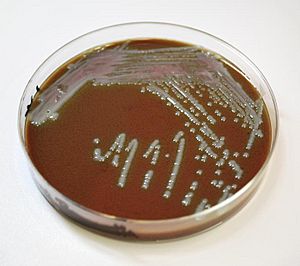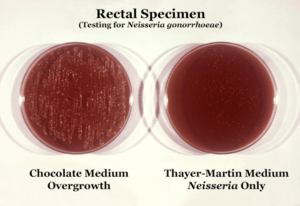Chocolate agar facts for kids
Chocolate agar, also known as CHOC or chocolate blood agar (CBA), is a special kind of food for tiny living things called bacteria. Scientists use it to grow and study bacteria that can cause sickness. Even though it's called "chocolate," it doesn't have any real chocolate in it! It just looks brown, like chocolate.

Contents
What is Chocolate Agar?
Chocolate agar is a type of "growth medium." Think of it like a special jelly or food that helps bacteria grow in a lab. It's made from blood, but the red blood cells in it have been gently heated until they break open. This process is called "lysis." The heating is done slowly, usually to about 80°C (176°F).
This special heating process is important because it releases important nutrients from inside the red blood cells. These nutrients are like vitamins for certain picky bacteria. For example, bacteria like Haemophilus influenzae and Neisseria meningitidis need these released nutrients to grow well. These bacteria are often found in the respiratory system.
Two key nutrients released are called nicotinamide adenine dinucleotide (NAD, also known as factor V) and hemin (factor X). These factors are crucial for the growth of many fastidious bacteria. The heating also helps by stopping certain enzymes that could destroy NAD.
Different Types of Chocolate Agar
Scientists can add different things to chocolate agar to make it more specific. This helps them grow only certain types of bacteria.
Chocolate Agar with Bacitracin
When a substance called bacitracin is added to chocolate agar, it becomes special for growing bacteria from the genus Haemophilus. Bacitracin stops other types of bacteria from growing, making it easier to find Haemophilus.
Thayer-Martin Agar
Another special type of chocolate agar is called Thayer-Martin agar. This one has a mix of different antibiotics. These antibiotics are added to stop most bacteria from growing, but they allow specific Neisseria species to grow. This is very helpful for identifying these particular bacteria.
See also
 In Spanish: Agar chocolate para niños
In Spanish: Agar chocolate para niños


